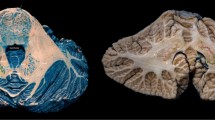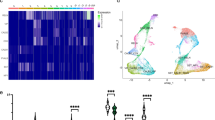Summary
The present study was performed to investigate the influence of intrastriatal fetal mesencephalic grafts on dopaminergic mRNA expression in the non-lesioned substantia nigra pars compacta of unilaterally 6-hydroxydopamine-lesioned rats. The expression of dopamine transporter mRNA, synaptic vesicular monoamine transporter mRNA and tyrosine hydroxylase mRNA was assessed in adjacent cryostat sections using in situ hybridization. Rotational behavior induced by apomorphine and amphetamine as well as hybridization of striatal sections cut at the grafting coordinates were used to prove the functional recovery and the presence of grafted cells, respectively. After grafting, the number of rotations was decreased and hybridization signals overlying cells in the grafted striatum were detected. Mean grain densities overlying labeled neurons in the substantia nigra pars compacta of grafted rats were compared to those of shamgrafted rats and revealed differential expression of dopamine transporter mRNA, whereas synaptic vesicular monoamine transporter mRNA and tyrosine hydroxylase mRNA expression showed no difference. The results will be discussed in relation to previous in vitro and in vivo studies suggesting a reduction of functional dopamine transporter molecules in the contralateral striatum.
Similar content being viewed by others
References
Björklund A, Dunnett SB (1992) Neural transplantation in adult rats. In: Dunnett SB, Björklund A (eds) Neural transplantation — a practical approach. Oxford University Press, New York, pp 57–78
Björklund A, Stenevi U (1979) Reconstruction of nigrostriatal dopamine pathway by intracerebral nigral transplants. Brain Res 177: 550–560
Cambi F, Fung B, Chikaraishi D (1989) 5′Flanking DNA sequences direct cell-specific expression of rat tyrosine hydroxylase. J Neurochem 53: 1656–1659
Caviness JN, Wightman RM (1982) Use of rapid superfusion to differentiate the release of dopamine from striatal tissue induced by sympathomimetic amines from release induced by potassium. J Pharmacol Exp Ther 223: 90–96
Cerruti C, Walther DM, Kuhar MJ, Uhl GR (1993) Dopamine transporter mRNA expression is intense in rat midbrain neurons and modest outside midbrain. Mol Brain Res 18: 181–186
Chritin M, Savasta M, Mennicken F, Bal A, Abrous DN, Le Moal M, Feuerstein C, Herman JP (1992) Intrastriatal dopamine-rich implants reverse the increase of dopamine D2 receptor mRNA levels caused by lesion of the nigrostriatal pathway: a quantitative in situ hybridization study. Eur J Neurosci 4: 663–672
Donovan DM, Vandenbergh DJ, Perry MP, Bird GS, Ingersoll R, Nanthakumar E, Uhl GR (1995) Human and mouse dopamine transporter genes: conservation of 5′-flanking sequence elements and gene structures. Mol Brain Res 30: 327–335
Earl CD, Marburger A, Schönfuss D, Sautter J, Strecker S, Yang Z, Kupsch A, Oertel WH, Morgenstern R (1996a) Foetal ventral mesencephalic cell suspension grafts to the 6-hydroxydopamine-lesioned rat reduce the rate of dopamine uptake in the contralateral striatum. Neurosci Lett 210: 185–188
Earl CD, Reum T, Xie J-X, Kupsch A, Oertel WH, Morgenstern R (1996b) Influences of foetal nigral cell suspension grafts on dopamine release in the non-grafted side in the 6-hydroxydopamine rat model of Parkinson’s disease: in vivo voltammetrie data. Exp Brain Res 109: 179–184
Erickson JD, Eiden LE, Hoffman BJ (1992) Expression cloning of a reserpine-sensitive vesicular monoamine transporter. Proc Natl Acad Sci USA 89: 10993–10997
Fass B, Butcher LL (1981) Evidence for a crossed nigrostriatal pathway in rats. Neurosci Lett 22: 109–113
Forni C, Brundin P, Strecker RE, El Ganouni S, Björklund A, Nieoullon A (1989) Time-course of recovery of dopamine neuron activity during reinnervation of the denervated striatum by fetal mesencephalic grafts as assessed by in vivo voltammetry. Exp Brain Res 76: 75–87
Freed WJ, Olson L, Ko G, Morihise JM, Niehoff D, Strömberg I, Kuhar M, Hoffer BJ, Wyatt RJ (1985) Intraventricular substantia nigra grafts: mechanisms of action and [3H]spiperidol autoradiography. In: Björklund A, Stenevi U (eds) Neural grafting in the mammalian CNS. Elsevier, Amsterdam, pp 472–489
Freund TF, Bolam JP, Björklund A, Stenevi U, Dunnett SB, Powell JF, Smith AD (1985) Efferent synaptic connections of grafted dopaminergic neurons reinnervating the host neostriatum: a tyrosine hydroxylase immunocytochemical study. J Neurosci 5: 603–616
Gerlach M, Riederer P (1996) Animals models of Parkinson’s disease: an empirical comparison with the phenomenology of the disease in man. J Neural Transm 103: 987–1041
Glowinski J, Besson MJ, Cheramy A (1984) Role of the thalamus in the bilateral regulation of dopaminergic and GAB Aergic neurons in the basal ganglia. Ciba Found Symp 107: 150–163
Grima B, Lamouroux A, Blanet F, Faucon Biguet N, Mallet J (1985) Complete coding sequence of rat tyrosine hydroxylase mRNA. Proc Natl Acad Sci USA 82: 617–621
Herman J-P, Abrous DN (1994) Dopaminergic neural grafts after fifteen years: results and perspectives. Prog Neurobiol 44: 1–35
Hitri A, Hurd YL, Wyatt RJ, Deutsch SI (1994) Molecular, functional and biochemical characteristics of the dopamine transporter: regional differences and clinical relevance. Clin Neuropharmacol 17: 1–22
Hoffer BJ, Gerhard GA, Rose GM, Strömberg I, Olson L (1987) Voltammetric analysis of nigral graft function. Ann NY Acad Sci 495: 511–527
Kilty JE, Lorang D, Amara SG (1991) Cloning and expression of a cocaine-sensitive rat dopamine transporter. Science 254: 578–579
Lamouroux A, Faucon Biguet N, Samolyk D, Salomon JC, Pujol JF, Mallet J (1982) Identification of cDNA clone coding for rat tyrosine hydroxylase-antigene. Proc Natl Acad Sci USA 79: 3881–3885
Lewis EJ, Harrington CA, Chikaraishi D (1987) Transcriptional regulation of the tyrosine hydroxylase gene by glucocorticoid and cyclic AMP. Proc Natl Acad Sci USA 84: 3550–3554
Lindvall O, Brundin P, Widner H, Rehncrona S, Gustavii B, Frackowiak R, Leenders KL, Sawle G, Rothwell JC, Marsden CD (1990) Grafts of fetal dopamine neurons survive and improve motor function in Parkinson’s disease. Science 247: 574–577
Liu Y, Peter D, Roghani A, Schuldiner S, Prive GG, Eisenberg D, Brecha N, Edwards RH (1992) A cDNA that suppresses MPP+ toxicity encodes a vesicular amine transporter. Cell 70: 539–551
Mahalik TJ, Finger TE, Strömberg I, Olson L (1985) Substantia nigra transplants into the denervated striatum of the rat: ultrastructure of graft and host interconnections. J Comp Neurol 240: 60–70
Nieoullon A, Cheramy A, Glowinski J (1977) Interdependence of the nigrostriatal dopaminergic systems on the two sides of the brain in the cat. Science 198: 416–418
Perlow MJ, Freed WJ, Hoffer BJ, Seiger A, Olson L, Wyatt RF (1979) Brain grafts reduce motor abnormalities produced by destruction of nigrostriatal dopamine system. Science 204: 643–647
Peschanski M, Defer G, N’Guyen JP, Ricolfi F, Monfort JC, Remy P, Geny C, Samson Y, Hantraye P, Jeny R, Gaston A, Kéravel Y, Degos JD, Cesaro P (1994) Bilateral motor improvement and alteration of L-dopa effect in two patients with Parkinson’s disease following intrastriatal transplantation of foetal ventral mesencephalon. Brain 117: 487–499
Reum T, Morgenstern R (1994) Fetal mesencephalic grafts influence the dopamine release in the non-lesioned striatum of 6-OHDA-lesioned rats: a behavioural and in vivo voltammetric study. Neurosci Lett 173: 172–176
Reum T, Schäfer U, Morgenstern R (1993) Involvement of the non-lesioned striatum in functional recovery of rats with 6-OHDA-induced hemiparkinsonism: in vivo and in vitro studies. Soc Neurosci Abstr 19: 683
Reum T, Schönfuß D, Schäfer U, Marburger A, Drandarevski N, Morgenstern R (1995) Fetal mesencephalic grafts decrease the rate of dopamine uptake in the non-lesioned striatum of unilaterally 6-OHDA-lesioned rats: an in vivo voltammetric study. Neurosci Lett 198: 218–222
Rodriguez M, Castellano MA, Palarea MD (1990) Interhemispheric regulation of dopaminergic ascending systems. Life Sci 47: 377–384
Romo R, Cheramy A, Godeheu G, Glowinski J (1986) In vivo presynaptic control of dopamine release in the cat caudate nucleus. III. Further evidence for the implication of corticostriatal glutamatergic neurons. Neuroscience 19: 1091–1099
Schäfer U, Bräutigam K, Bianga C, Drandarevski N, Morgenstern R (1995) Dopaminergic grafts reduce the [3H]WIN 35,428 binding to dopamine transporters of the non-lesioned striatum. Soc Neurosci Abstr 21: 318
Schäfer U, Reum T, Morgenstern R (1995) Graft-induced reduction in [3H]dopamine uptake into the non-lesioned striatum. NeuroReport 6: 782–784
Schäfer U, Reum T, Schönfuß D, Marburger A, Morgenstern R (1995) Grafts modulate dopamine transporters of the non-lesioned striatum. NeuroReport 6: 1833–1836
Shimada S, Kitayama S, Lin C-L, Nanthankumar E, Gregor P, Patel A, Kuhar M, Uhl G (1991) Cloning and expression of a cocaine-sensitive dopamine transporter cDNA. Science 254: 576–578
Shimada S, Kitayama S, Walther D, Uhl G (1992) Dopamine transporter mRNA: dense expression in ventral midbrain neurons. Mol Brain Res 13: 359–362
Sulzer D, Maidment NT, Rayport S (1993) Amphetamine and other weak bases act to promote reverse transport of dopamine in ventral midbrain neurons. J Neurochem 60: 527–535
Surratt CK, Wang J-B, Yuhasz S, Amzel M, Kwon HM, Handler JS, Uhl GR (1993) Sodium- and chloride-dependent transporters in brain, kidney, and gut: lessons from complementary DNA cloning and structure-function studies. Curr Opin Nephrol Hypertens 2: 744–760
Takahashi N, Uhl GR (1997) Murine vesicular monoamine transporter 2: molecular cloning and genomic structure. Mol Brain Res 49: 7–14
Tolwani RJ, Jakowec MW, Petzinger GM, Green S, Waggie K (1999) Experimental models of Parkinson’s disease: insights from many models. Lab Anim Sci 49: 363–371
Uhl GR (1986) In situ hybridization in brain. Plenum, New York, 300 pp
Zainos-Rosales A, Aguilar-Roblero R, Mendoza-Ramirez J-L, Drucker-Colin R (1993) 2-Deoxyglucose autoradiography evidence that fetal substantia nigra grafts exert contralateral effects in 6-hydroxydopamine-lesioned animals who recover motor asymmetries. Neurosci Lett 156: 99–104
Zetterström T, Brundin P, Gage FH, Sharp T, Isacson O, Dunnett SB, Ungerstedt U, Björklund A (1986) In vivo measurement of spontaneous release and metabolism of dopamine from intrastriatal nigral grafts using intracerebral dialysis. Brain Res 362: 344–349
Author information
Authors and Affiliations
Rights and permissions
About this article
Cite this article
Drandarevski, N., Marburger, A., Walther, D. et al. Dopaminergic mRNA expression in the intact sebstantia nigra of unilaterally 6-OHDA-lesioned and grafted rats: an in situ hybridization study. J Neural Transm 108, 141–151 (2001). https://doi.org/10.1007/s007020170084
Received:
Accepted:
Issue Date:
DOI: https://doi.org/10.1007/s007020170084




